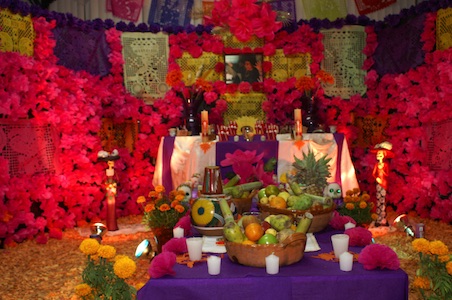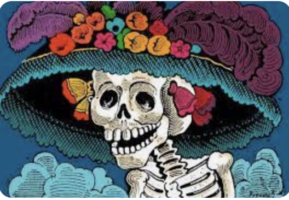Dia de Muertos – helping the spirits find their way home.
By Maaike Hoekstra, September 2017. Maaike is the owner and founder of Flavor Teller, Mazatlan’s only street food tour and rated #13 by TripAdvisor in 2021, as one of the best experiences world-wide. If you are interested in Flavor Teller, or Maaike’s very special Dia de Muertos food tour please click here.]
Mexico’s most characteristic and perhaps oldest fiesta, Dia de Muertos (Day of the Dead), has its origins in the belief of the pre-Hispanic Tarasco people from Michoacan that the dead could return to their homes on one day each year. This tradition was declared Intangible Cultural Heritage of Humanity by UNESCO in 2008. UNESCO formed this to ensure better protection of important cultural traditions.
 The underlying philosophy behind Dia de Muertos is that death does not represent the end of a life but a continuation of life in a parallel world. The day when the dead could return is a month after the autumn equinox. The occasion required preparations to help the spirits find their way home and make them welcome. An arch of bright yellow marigold flowers was put up in each home, as a symbolic doorway from the underworld. Tamales, fruits, corn and salt were placed in front of the arch on an altar, along with containers of water; because spirits always arrived thirsty after their journey. Traditionally, the spirits of departed children are visited on the first night and spirits of dead adults came on the following night, when they joined their living relatives to eat, drink, talk and sing.
The underlying philosophy behind Dia de Muertos is that death does not represent the end of a life but a continuation of life in a parallel world. The day when the dead could return is a month after the autumn equinox. The occasion required preparations to help the spirits find their way home and make them welcome. An arch of bright yellow marigold flowers was put up in each home, as a symbolic doorway from the underworld. Tamales, fruits, corn and salt were placed in front of the arch on an altar, along with containers of water; because spirits always arrived thirsty after their journey. Traditionally, the spirits of departed children are visited on the first night and spirits of dead adults came on the following night, when they joined their living relatives to eat, drink, talk and sing.
The Catholic celebrations of All Saints’ Day (November 1st) and All Souls’ Day (November 2nd) were easily superimposed on the ancient Day of the Dead traditions, which shared much of the same symbolism – flowers, candles and offerings of food and drink. All Souls’ Day is the Catholic day of prayers for those in purgatory, All Saints’ Day was understood as a visit by the spirits of children who immediately became angelitos (little angels) when they died. The growing mestizo community evolved a new tradition of visiting graveyards and decorating graves of family members.
Dia de Muertos persisted in the guise of the Catholic celebration throughout the colonial period when the idea of death as a leveler and release from earthly suffering must have provided comfort for the overwhelmingly poor population. After Mexican independence, poets used the occasion to publish verses ridiculing members of the social elite by portraying them as dead, with all their wealth and pretensions rendered futile.
 Calaveras – skeletal figures of Death cheerfully engaging in everyday life, working, dancing, courting, drinking and riding horses into battle. One of his most enduring characters is La Calavera Catrina, a female skeleton in an elaborate low-cut dress and flamboyant flower-covered hat, suggestively revealing a bony leg and an ample bust that is all ribs and no cleavage.
Calaveras – skeletal figures of Death cheerfully engaging in everyday life, working, dancing, courting, drinking and riding horses into battle. One of his most enduring characters is La Calavera Catrina, a female skeleton in an elaborate low-cut dress and flamboyant flower-covered hat, suggestively revealing a bony leg and an ample bust that is all ribs and no cleavage.
Among indigenous communities, most notably the Purépecha of Michoacan (descendants of the pre-Hispanic Tarascos), Dia de Muertos is still very much a religious and spiritual event. For them, the observance is more appropriately called Noche de Muertos (Night of the Dead), because families actually spend whole nights at the graveyard – the night of October 31/November 1 with the spirits of dead children, the following night with the spirits of dead adults.
For Mexico’s mestizo majority, Dia de Muertos is more of a popular folk festival and family occasion. People may visit a graveyard to clean and decorate family graves, but they do not usually maintain an all-night vigil. And though they may pray for the souls of the departed and build altars in their homes to welcome them back, the Catholic belief is that those souls are in heaven or in purgatory, not actually back on a visit to Earth. Sugar skulls, chocolate coffins and toy skeletons are sold in markets everywhere as gifts for children as well as graveyard decorations.
The altar that people create is decorated with bright cempasuchil (marigold) flowers, candles, salt and water, plates of tamales, sugar-shaped skulls and pan de muertos (bread of the dead; a softened sweet bread in the shape of a bun), and the favorite foods of the deceased are laid out so that they feel welcome upon their return. Many government offices, homes, galleries and businesses set up their altars and you’ll certainly see many on your way through town.
In the center and south of Mexico, Dia de Muertos is a solemn celebration. But Mazatlan celebrates in its own exuberant way on Wednesday November 1. Home to the biggest beer brewery on the Pacific coast, until a few years ago there was a donkey pulling a cart with barrels of beer from where the alcohol would flow freely during the evening of Dia de Muertos. 
Today, organizers have provided three to four trucks serving large jugs of beer into plastic cups – people happily follow these trucks along the narrow streets of Centro and the adults love their cups them to the brim.
 This boisterous street parade once again passes by altars that have been set-up in the historic center; Altars are throughout Centro Historico so do stop by and pay your respect to those family altars. There are several people that embody ‘Death’ or La Calavera Catrina with elaborate carnaval-like gowns. In the procession there is Sinaloa ‘banda’ playing live music and there are many people that are dressed up as calacas (colloquial name for skeletons) that dance to the music. The celebration in Mazatlan is not solemn, but more festive. I invite you to embrace the spirit of Dia de Muertos – the Mazatlan way!
This boisterous street parade once again passes by altars that have been set-up in the historic center; Altars are throughout Centro Historico so do stop by and pay your respect to those family altars. There are several people that embody ‘Death’ or La Calavera Catrina with elaborate carnaval-like gowns. In the procession there is Sinaloa ‘banda’ playing live music and there are many people that are dressed up as calacas (colloquial name for skeletons) that dance to the music. The celebration in Mazatlan is not solemn, but more festive. I invite you to embrace the spirit of Dia de Muertos – the Mazatlan way!
